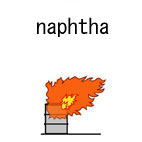| Case Name |
Leakage and fire of naphtha caused due to overlooking of an open drain valve at an ethylene plant |
| Pictograph |

|
| Date |
May 16, 1989 |
| Place |
Takaishi, Osaka, Japan |
| Location |
Chemical factory |
| Overview |
On May 16th, 1989, leaked naphtha ignited and started a fire around a cracking furnace at an olefin manufacturing plant in Osaka. Of 16 cracking furnaces, No.3 furnace was to be decoked. After stopping the supply of naphtha, the naphtha piping was steam-purged, and then steam-purging of ethane piping started. A fire started around the drain valve of the piping. |
| Incident |
The piping was purged for decoking a cracking furnace. The drain valve had been open and naphtha leaked from the piping. The naphtha ignited and a fire started. |
| Processing |
Manufacture |
| Individual Process |
Maintenance |
| Process Flow |
Fig2.Unit process flow
|
| Substance |
Naphtha |
| Type of Accident |
Leakage, fire |
| Sequence |
Out of 16 cracking furnaces, No.3 furnace was to be decoked. After stopping the supply of naphtha, supply piping was steam-purged. Soon after steam-purging of ethane piping, a fire started around a drain valve.
Decoking: Removal of hard carbonized compounds adhering to the inside wall of a furnace tube. At an ethylene plant, this is usually done with air and steam. |
| Cause |
A drain valve of ethane piping had been left open after previously decoking the furnace. Naphtha remaining at a joint of ethane and naphtha lines back-flowed via the ethane line into the atmosphere, and was ignited by a flame in the furnace. The accident resulted from human error at the previous operation and line-up mistakes at the beginning of the operation. |
| Response |
An emergency shutdown of the plant. |
| Countermeasures |
1. Removing unnecessary drain valves.
2. Thorough confirmation of valve operations.
3. Re-education on site management. |
| Knowledge Comment |
Decoking lines are usually used after long interval, so inappropriate operations may not directly lead to immediate trouble. Line-up operation at reuse after decoking should be done carefully. |
| Background |
1. The drain valve had been left open since the previous decoking. This was a serious mistake in repair and operation management. A drain valve should be closed and capped or equipped with a blind flange when it is not in use to prevent leakage. It was also a serious mistake not to cap the drain valve.
2. The shape of the joint of an ethane line and a naphtha line might have been inappropriate. |
| Incidental Discussion |
For piping that joins two liquids, and that requires purging or draining, the drain valve should be downstream of the junction and installed as close as possible to the junction. |
| Reason for Adding to DB |
Example of fire caused due to overlooking of small matters of the field management |
| Scenario |
| Primary Scenario
|
Carelessness, Insufficient Precaution, As Usual, Organizational Problems, Poor Management, Slackness of Management, Planning and Design, Poor Planning, Inadequate Design, Regular Movement, Wrong Movement, No Action, Secondary Damage, External Damage, Leakage/Fire, Bodily Harm, Injury, 1person injured
|
|
| Sources |
Fire and Disaster Management Agency. Naphtha leakage and fire near olefin manufacturing cracking furnace. Accident cases of dangerous materials. pp.314-315
High Pressure Gas Safety Inst. of Japan. High-pressure gas protection overview. pp.153, 164-165(1990).
High Pressure Gas Safety Inst. of Japan. Ethylene manufacturing plant. Raw material naphtha leakage and ignition. Accident Examples of Petroleum Refinery and Petrochemical units. pp.113-116(1995)
|
| Number of Injuries |
1 |
| Physical Damage |
No.3 cracking furnace, ethane piping, insulation and vaives were damaged. Electricity and instrument cables were partially destroyed by fire. About 50 L of naphtha was lost. |
| Financial Cost |
¥2 million (Accident cases of dangerous materials) |
| Field |
Chemicals and Plants
|
| Author |
YOSHINAGA, Jun (Graduate School of New Frontier Sciences, The University of Tokyo)
TAMURA, Masamitsu (Center for Risk Management and Safety Sciences, Yokohama National University)
|